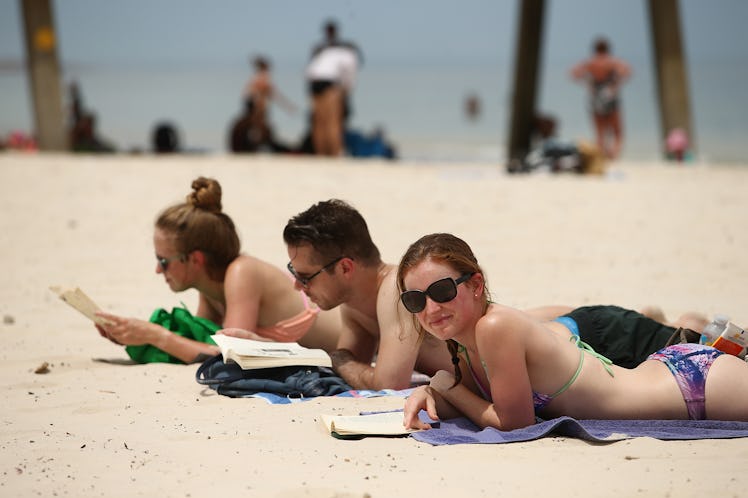
Dermatologists Reveal Whether Or Not Super High SPF Sunscreens Actually Make A Difference
Summer is now officially in full swing. And with the warmer weather settling in, many of us are leaning toward wearing less clothing and heading to more beaches to soak up the sun. But that also means we need to be aware of UV exposure and the damage it can do to our skin. Of course, applying sunblock is the obvious solution, but does sunscreen with high SPF matter when it comes to increased skin protection? The answer can be complicated, according to the experts. But the bottom line is that re-applying is the key to getting continuous protection.
In May, a study published by the Journal of the American Academy of Dermatology suggested that SPF 100 offered more protection against sunburn and other ailments related to sun exposure, compared to SPF 50. But some dermatologists say that an SPF that high isn't always necessary.
"An SPF of 30 to 45 will be OK for everyone," Dr. Jeanine Downie, of Image Dermatology P.C. in New Jersey, explains. "But they do have to be re-applied every two hours if you’re in the New Jersey, New York area. If you’re in the South or close to the equator, then it’s every hour." And that applies to everyone, regardless of ethnicity.
She also adds that, according to the Skin Cancer Foundation, once you get to SPF 45, the level of protection will start to even out.
On the other hand, though, Dr. Dendy Engelman, a dermatologic surgeon at Manhattan Dermatology and Cosmetic Surgery, still says the higher the SPF, the better. But she adds that studies tend to differ from what we actually do and practice in our day-to-day lives.
"When I talk to my patients about whether we need an SPF 50 or 100, the reality is we never apply the amount in practicality that they do when they’re testing it in the studies," she says. "Rule of thumb, take whatever is on the bottle and divide it by two and that is about what you’re getting. So in that line of thinking, the higher, the better — go higher to convey more protection. The newest studies substantiate that."
When looking for sunscreen, the experts all agree that it's important to find a brand that offers "broad spectrum" protection, meaning that it will block out both UVA and UVB rays. The difference between the two is that while UVA rays causes the type of skin damage that leads to wrinkles and sun spots, UVB rays are what cause sunburns. But both can lead to skin cancer.
"Most high SPF products do offer broad spectrum protection against both rays," Dr. Joshua Zeichner, Director of Cosmetic and Clinical Research at Mount Sinai Hospital in New York City, shares. "However, lower SPF sunscreen may only protect against UVB rays, so it’s important to make sure it says broad spectrum on the label."
Dr. Downie recommends affordable broad spectrum sunscreens from Aveeno and Neutrogena, which she says have been tested and proven to work effectively. But if you're willing to spend upwards of $60 to protect your skin, Dr. Engelman gives both Elizabeth Arden's Prevage City Smart Broad Spectrum SPF 50 Hydrating Shield or Skin Medica's Total Defense + Repair the thumbs up.
For those with sensitive skin who may not react well to traditional sunscreens, Dr. Zeichner recommends using mineral-based products instead. He adds that they should always contain either zinc oxide by itself, or in combination with titanium dioxide. He continues that many high level SPF mineral formulas exist, but most are labeled as products for kids, like Aveeno's Baby Continuous Protection, for example. Dr. Downie adds that if your skin is just sensitive to the sun itself, wearing protective clothing from brands like UV Skinz in addition to high SPF sunscreen is a must.
When it comes to actual application of the product, each doctor agrees that it needs to be applied all over, and they literally mean everywhere. Dr. Zeichner says that people often forget little areas, from the part in their hair to the tops of their ears and the back of their hands. Many also forget to apply a lip balm that contains SPF. Dr. Downie adds that dermatologists often see a lot of skin cancers in places like the feet and the back of the neck, ears, and legs — areas that people often skip. Finally, Dr. Engelman concludes that around the hairline, into the scalp, and in between fingers and toes are some of the most important areas to remember as well.
So next time you're planning to be out in the sun, remember to apply — and continuously reapply — the proper sunscreen that will give you full protection. Trust me (and the experts), your skin will thank you!